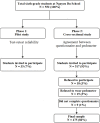Comparison between self-reported and pedometer-measured physical activity in Vietnamese adolescents: A reliability and agreement study
- PMID: 40478864
- PMCID: PMC12143546
- DOI: 10.1371/journal.pgph.0004725
Comparison between self-reported and pedometer-measured physical activity in Vietnamese adolescents: A reliability and agreement study
Abstract
To compare the level of physical activity (PA) measured by self-reported questionnaire and pedometer in 12-year-old Vietnamese adolescents. Data was collected from March to May 2023 in two phases among 510 sixth-grade students in Ho Chi Minh City, Vietnam. The first phase involved a pilot study, which recruited 35 students from a randomly selected class to evaluate the Physical Activity Questionnaire for Older Children (PAQ-C) test-retest reliability. PA was measured twice, with seven-day intervals between assessments. The second phase was a cross-sectional study including 475 sixth-grade students to evaluate the agreement between PAQ-C scores and pedometer data. Participants wore a pedometer continuously for seven days and completed the PAQ-C at the end of the monitoring period. Sociodemographic and anthropometric data were collected. The sample of 35 students showed that PAQ-C demonstrated good internal consistency (α = 0.89) and test-retest reliability (ICC = 0.82). After one week, McNemar's test indicated no significant difference in activity levels between the baseline and second assessment. In the sample of 475 students, there was a substantial agreement between PAQ-C and pedometer in classifying physical activity levels (Cohen's κ = 0.688, p < 0.001), with a strong correlation between daily step counts and PAQ-C scores (rs = 0.855, p < 0.001). PAQ-C is a reliable, cost-effective tool for school-based PA monitoring in 12-year-old Vietnamese adolescents, particularly in resource-limited settings.
Copyright: © 2025 Truong et al. This is an open access article distributed under the terms of the Creative Commons Attribution License, which permits unrestricted use, distribution, and reproduction in any medium, provided the original author and source are credited.
Conflict of interest statement
The authors have declared that no competing interests exist.
Figures
Similar articles
-
Reliability and validity of Web-SPAN, a web-based method for assessing weight status, diet and physical activity in youth.J Hum Nutr Diet. 2012 Feb;25(1):59-68. doi: 10.1111/j.1365-277X.2011.01181.x. Epub 2011 May 27. J Hum Nutr Diet. 2012. PMID: 21615806
-
[Reliability and validity of the PAQ-A questionnaire to assess physical activity in Spanish adolescents].Rev Esp Salud Publica. 2009 May-Jun;83(3):427-39. doi: 10.1590/s1135-57272009000300008. Rev Esp Salud Publica. 2009. PMID: 19701574 Spanish.
-
The prevalence and determinants of physical activity in secondary Vietnamese students: a hierarchical analysis.BMC Public Health. 2025 May 7;25(1):1694. doi: 10.1186/s12889-025-22308-z. BMC Public Health. 2025. PMID: 40335956 Free PMC article.
-
Self-administered physical activity questionnaires for the elderly: a systematic review of measurement properties.Sports Med. 2010 Jul 1;40(7):601-23. doi: 10.2165/11531350-000000000-00000. Sports Med. 2010. PMID: 20545382
-
Folic acid supplementation and malaria susceptibility and severity among people taking antifolate antimalarial drugs in endemic areas.Cochrane Database Syst Rev. 2022 Feb 1;2(2022):CD014217. doi: 10.1002/14651858.CD014217. Cochrane Database Syst Rev. 2022. PMID: 36321557 Free PMC article.
References
-
- Mason P, Curl A, Kearns A. Domains and levels of physical activity are linked to adult mental health and wellbeing in deprived neighbourhoods: A cross-sectional study. Mental Health Phys Act. 2016;11:19–28. doi: 10.1016/j.mhpa.2016.07.001 - DOI
-
- World Health Organization. Global action plan on physical activity 2018–2030: more active people for a healthier world [Internet]. Geneva: World Health Organization; 2018. Jun 1 [cited 2023 October 12]. Available from: https://www.who.int/publications/i/item/9789241514187
LinkOut - more resources
Full Text Sources


